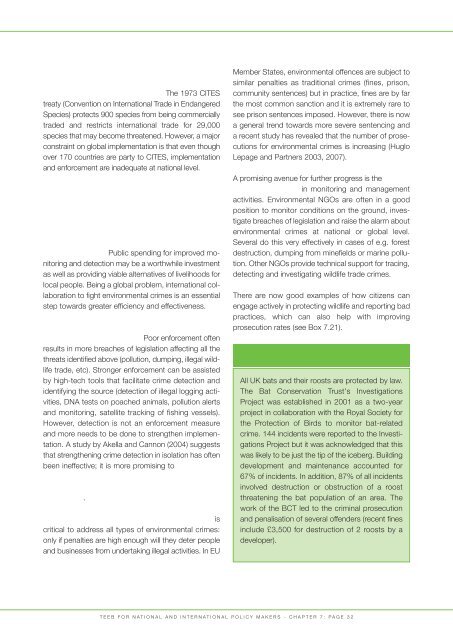Download (PDF, 6.71MB) - TEEB
Download (PDF, 6.71MB) - TEEB
Download (PDF, 6.71MB) - TEEB
Create successful ePaper yourself
Turn your PDF publications into a flip-book with our unique Google optimized e-Paper software.
The 1973 CITES<br />
treaty (Convention on International Trade in Endangered<br />
Species) protects 900 species from being commercially<br />
traded and restricts international trade for 29,000<br />
species that may become threatened. however, a major<br />
constraint on global implementation is that even though<br />
over 170 countries are party to CITES, implementation<br />
and enforcement are inadequate at national level.<br />
Public spending for improved monitoring<br />
and detection may be a worthwhile investment<br />
as well as providing viable alternatives of livelihoods for<br />
local people. Being a global problem, international collaboration<br />
to fight environmental crimes is an essential<br />
step towards greater efficiency and effectiveness.<br />
Poor enforcement often<br />
results in more breaches of legislation affecting all the<br />
threats identified above (pollution, dumping, illegal wildlife<br />
trade, etc). Stronger enforcement can be assisted<br />
by high-tech tools that facilitate crime detection and<br />
identifying the source (detection of illegal logging activities,<br />
DNA tests on poached animals, pollution alerts<br />
and monitoring, satellite tracking of fishing vessels).<br />
however, detection is not an enforcement measure<br />
and more needs to be done to strengthen implementation.<br />
A study by Akella and Cannon (2004) suggests<br />
that strengthening crime detection in isolation has often<br />
been ineffective; it is more promising to<br />
.<br />
is<br />
critical to address all types of environmental crimes:<br />
only if penalties are high enough will they deter people<br />
and businesses from undertaking illegal activities. In EU<br />
Member States, environmental offences are subject to<br />
similar penalties as traditional crimes (fines, prison,<br />
community sentences) but in practice, fines are by far<br />
the most common sanction and it is extremely rare to<br />
see prison sentences imposed. however, there is now<br />
a general trend towards more severe sentencing and<br />
a recent study has revealed that the number of prosecutions<br />
for environmental crimes is increasing (huglo<br />
Lepage and Partners 2003, 2007).<br />
A promising avenue for further progress is the<br />
in monitoring and management<br />
activities. Environmental NGos are often in a good<br />
position to monitor conditions on the ground, investigate<br />
breaches of legislation and raise the alarm about<br />
environmental crimes at national or global level.<br />
Several do this very effectively in cases of e.g. forest<br />
destruction, dumping from minefields or marine pollution.<br />
other NGos provide technical support for tracing,<br />
detecting and investigating wildlife trade crimes.<br />
There are now good examples of how citizens can<br />
engage actively in protecting wildlife and reporting bad<br />
practices, which can also help with improving<br />
prosecution rates (see Box 7.21).<br />
All UK bats and their roosts are protected by law.<br />
The Bat Conservation Trust's Investigations<br />
Project was established in 2001 as a two-year<br />
project in collaboration with the Royal Society for<br />
the Protection of Birds to monitor bat-related<br />
crime. 144 incidents were reported to the Investigations<br />
Project but it was acknowledged that this<br />
was likely to be just the tip of the iceberg. Building<br />
development and maintenance accounted for<br />
67% of incidents. In addition, 87% of all incidents<br />
involved destruction or obstruction of a roost<br />
threatening the bat population of an area. The<br />
work of the BCT led to the criminal prosecution<br />
and penalisation of several offenders (recent fines<br />
include £3,500 for destruction of 2 roosts by a<br />
developer).<br />
<strong>TEEB</strong> FoR NATIoNAL AND INTERNATIoNAL PoLICy MAKERS - ChAPTER 7: PAGE 32

















